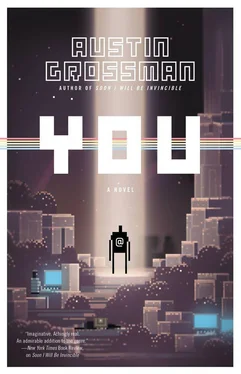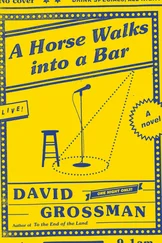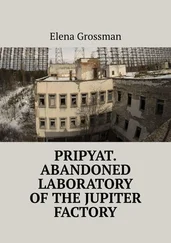Real cheering this time, and questions, everyone talking over each other, Dark Lorac, Endoria, conversation interfaces and hit location, something about the White City.
Darren stood up. It was the first time I’d heard him speak in years. I wondered if he knew I was there; I felt the urge to duck down. All of a sudden I felt ashamed at coming back, like I still wanted him to like me.
“Hi, guys,” he started. He spoke quietly, and everyone shut up instantly. “So what’s the Third Age about?”
He stopped and let the silence go on a little, the room completely still now; he had a knack for making eleven in the morning feel like a primal midnight. The lights dimmed a little—Matt was standing at the switch. Darren looked around the room at each of us. The screen behind him lit up, showing a series of screenshots from what I supposed were past Black Arts games: at first just a few characters and dots on a black screen, then a hypercomplex board game, fading forward to real images.
“The First Age is long gone, a fallen legend. The Second Age, a magical war that shattered the world. Now the Third Age. Four heroes battling for a thousand years, and for what? Simon’s notes don’t say. It’s up to us,” he said, and paused. Darren was good at this.
“I want you all to think about the Third Age, everything that happened there, the fall of Brennan’s house, Dark Lorac. How does the Third Age end? I mean, how did it end for you? What did you find at the end of a thousand years of struggle in the dirt and the rain, and what did you do with it? Were you brave? Did you win or lose? What did it take out of you?”
On-screen, the capsule history had gone to 3-D, a view of a warrior fighting wolves alone in a snowstorm. I thought about it. What was Darren’s story? What was Simon’s? Was he brave? Did he get what he wanted?
“It’s the end of the Third Age, people. You are going to slay gods.” A burst of applause, which Darren let run for a few seconds, then continued on. He had more coming.
“The ads talk about the technology. We’ll say it’s the fastest, most realistic graphics yet. We’re probably going to beat Carmack at id, we’ll beat Epic for sure. But it’s 1997, and games are about as realistic as they’re going to get, right?
“Think again. Big news, we’re throwing out all our old graphics tech, which means… a couple things. We’re ditching the Ukrainians, for good”—a modest cheer at that—“and we’re bringing in a fresh take on it. I’ve got a little surprise.”
Toby perked up a little, and then I saw Lisa. Her expression had changed very little, but her normally pale face was red almost to the hairline. She was watching Darren with what some might call nervousness, but it was more like hunger.
“I’ve been talking to a new person for this,” Darren said, and I saw Lisa’s posture straighten, flexing like a cat waiting to be petted. “We’re about to announce a partnership with NVIDIA, to be the flagship product for their next-gen graphics card. We’re going to get direct access to the software guys as well as their hardware team.”
I saw Lisa react. Her lips made the tiniest possible “no.” Otherwise her features didn’t change, they just went entirely slack, as if in shock. You would have to have known her a long time to catch the change. I thought I was the only one seeing it, until I saw Don’s eyes on her. Darren worked the room, but Don watched it.
Darren showed us a series of new screenshots. A waterfall with sunlight shining through it, forming a rainbow. A garishly lit nightclub where a generously proportioned, lingerie-clad woman danced on a pedestal, lit by multicolored spotlights. A domed temple with arches and gleaming black marble floors. The images looked like they’d taken a supercomputer a hundred hours to draw; they looked incredible.
Darren ticked off the list of features. “Translucency, curved surfaces, colored lights. Everything from a gamer’s wet dreams, all in real time. Bloom, specular highlights, insane poly counts, level of detail, all running at sixty frames a second, solid as a fucking rock. This is it, people.”
We were, yet again, looking across the threshold to the next thing, another phase change. Everything new this year was already becoming old, sad, and pathetic. Darren understood this so well. We were going into the future and he was taking us with him. We were the smart kids again, rich in the currency of our peculiar nation, foresight.
“And… number three,” Don said. “Scheduling.” Darren gave a quick nod, then ducked out the door while Don took us back into the mundane. Lisa followed behind Darren.
“We’re going to have about eighteen months for this one. We’ll be reusing a lot of tech, but it’s still going to be tight. Matt, could you—” Matt hopped up, and Don handed him a page of printout. He started sketching out a grid on the whiteboard on the wall.
Horizontally across the top, he wrote six items: PREPRODUCTION, ALPHA 1, ALPHA 2, ALPHA 3, BETA, and RTM.
At the right-hand edge, he wrote three words, arranged vertically: PROGRAMMING, DESIGN, and ART. These, I knew, were the three core disciplines of video game production. There was also production, which meant tracking the schedule, the budget, and doing a thousand other things, such as organizing translations for foreign publication, keeping in touch with publishers, and generally figuring out what on earth was going on at any given time. And then there was quality assurance, or playtesting, devoted to finding mistakes in other people’s work. No one was ever very fond of QA.
Don explained the schedule carefully—we’d have eighteen months for this, which put sharp limits on how much new technology we could create. I got the feeling this made the programmers feel a little pissed off. Working from the sheet, Matt began adding deadlines for each of these in neat, spiky handwriting. As Don talked us through the dates, I gradually picked up on rough meanings of the other terms.
Preproduction: planning the product and scheduling the milestones. As it would in a prolonged dorm-room discussion, the phrase “wouldn’t it be cool if” played a major part. Endless circular debates, pie-in-the-sky speculation. Lots of features that would be cut later for scheduling reasons.
Alpha phases 1, 2, and 3: building the game. This part was longer than the others put together, for obvious reasons. For most of this period, the game was going to be nonexistent or broken and decidedly unfun, and everyone would regret everything they said during preproduction.
Beta meant that the game, theoretically, was done except for all the many, many problems and mistakes and omissions.
RTM stood for “Release To Manufacturer,” when the finished master disk would be sent off to the publisher (note: we did not have a publisher). The publisher would do its own testing, and either accept it or send it back to have the problems fixed.
Of course none of these phases or deadlines would happen cleanly; there would be slippage and temporary solutions that would be fixed later, or, more often, become permanent. There would be interdependencies, times when art or programming couldn’t move forward because design hadn’t said what it wanted yet; or design couldn’t build its levels properly because art hadn’t produced the models or programmers hadn’t implemented the necessary features. It would be a dizzying creative collaboration that often took the form of a drawn-out, byzantine war of intrigue.
Preproduction started Monday. It was starting to sink in that this would be our lives for the next eighteen months. It was April then; it would be June when we started alpha 1 while my law school friends would be at graduation parties, the start of a lazy summer before moving on to New York or Palo Alto or New Haven, while I stayed behind in this made-up career. It would be June again when we got out of alpha 3, a year of my life gone, and it would be early October of next year when we reached RTM, and getting cold, and my life would be different in ways I couldn’t imagine yet.
Читать дальше





![Ally Carter - [Gallagher Girls 01] I'd Tell You I Love You But Then I'd Have to Kill You](/books/262179/ally-carter-gallagher-girls-01-i-d-tell-you-i-lo-thumb.webp)






